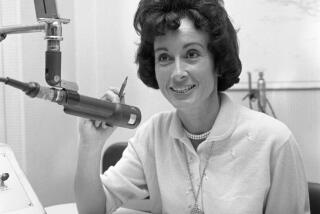Ruth Werner; Spy Gave Atomic Secrets to Soviets in 1940s
- Share via
Ruth Werner, a communist spy who transmitted atom bomb secrets from Britain to the Soviet Union in the 1940s, died Friday in her native Berlin. She was 93.
The death of Werner, who operated under the code name “Sonya” and gained the rank of colonel in the Red Army’s reconnaissance service, was announced by the former East German communist party. No cause of death was given.
As a Soviet spy in Britain in the 1940s, Werner was a key contact for Klaus Fuchs, the physicist who revealed secrets of the atomic bomb to the Kremlin from Britain and later from the U.S. laboratory at Los Alamos. Fuchs was caught and served 9 1/2 years in a British prison before going to East Germany, where he died in 1988.
Werner was never caught, and returned to East Germany a few years after Fuchs went to prison. She quit the espionage business but remained committed to advancing socialism. She found success as an author in 1977 when she published her memoirs, “Sonya’s Report.” She also wrote a novel, “An Unusual Girl,” and a biography of anti-Nazi resistance fighter Olga Benario, as well as some children’s books.
Born Ruth Kuczynski to a middle-class Jewish family in Berlin, Werner was the daughter of an official in the local statistical office. Trained as a bookseller, she joined the German Communist Party as a teenager in response to seeing World War I veterans, either blind or without legs, begging on the streets of Berlin.
“I saw the difference between the poor and the rich, and I felt this wasn’t right,” she later wrote.
She went to China with her first husband, Rolf Werner, in the 1920s and was recruited for espionage as a friend of German communist Richard Sorge, a Soviet master spy in the Far East who was executed by the Japanese in 1944.
After several secret trips to Moscow for training, Werner saw action as a radio operator in Manchuria, Poland and Switzerland before being stationed in Britain in 1941. She supplied intelligence on British military moves during the war to Moscow. She then worked with Fuchs--a German-born physicist who became a British citizen and worked at the Harwell nuclear laboratory before joining the U.S. nuclear bomb project at Los Alamos.
Werner stayed in Britain for nearly three years after her cover was blown in 1947 by a British agent. She earned a meager living taking in boarders and giving German lessons before she returned to Berlin in 1950.
Since the Berlin Wall fell and Germany reunited in 1990, Werner had lived reclusively in East Berlin.
Like many East Berliners, she viewed the reunification of Germany as a disaster. “It wasn’t reunification, it was annexation,” she told a reporter some years ago.
After the collapse of communist rule, she remained active in the reformed Communist Party of Democratic Socialism.
“I fought against fascism. I can hold my head up for that,” she recalled in an interview, but after being prodded about Soviet oppression over the years, she shook her head sadly.
“It’s not a good time to be old,” she said.
Werner, who was married twice, is survived by three children.
More to Read
Sign up for Essential California
The most important California stories and recommendations in your inbox every morning.
You may occasionally receive promotional content from the Los Angeles Times.













